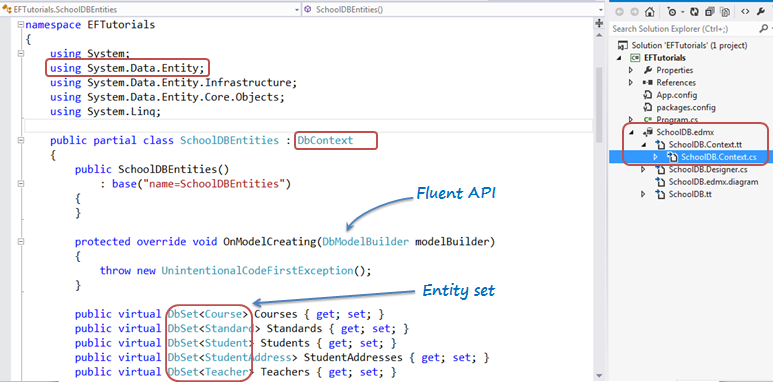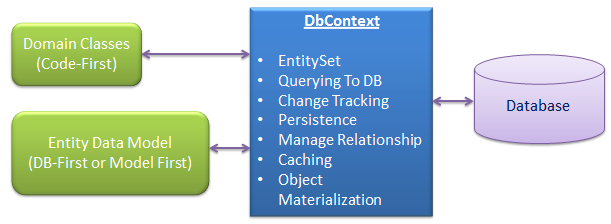DBContext:
在之前的章节《创建实体数据模型》中,EDM为我们创建了SchoolDBEntities 类,它派生子System.Data.Entity.DbContext这个类,这个DbContext在EF中被称作上下文类。

在EF4.1之前,EDM生成的上下文类是派生自ObjectContext这个类的。它有点难于使用。DbContext 在概念上类似于ObjectContext。DbContext 只是对ObjectContext 进行了封装使其更容易在所有开发场景中使用。(如Code First, Model First 和 Database First 中)
DbContext 是EF中重要的一环,它是数据库与你应用程序域或实体类的桥梁。

DbContext 是负责数据与对象互操作的主要的类型。它主要负责以下一些动作:
EntitySet : DbContext 包含所有从数据库表中被映射出来的实体对象的集合(如DbSet<TEntity>)。
Querying : DbContext 将LINQ To Entities 转化为SQL 查询语句并发送至数据库。
Change Tracking : 它保持变更追踪,一旦实体对象发生改变它就会从数据库中进行查询。
Persisting Data : 它也可以基于实体状态对数据库进行插入,更新和删除操作。
Caching : DbContext 默认作一级缓存,它存储在上下文类的生命周期中检索过的实体对象。
Manage Relationship : 在DB-First 或 Model-First 中 DbContext 使用CSDL, MSL 和 SSDL 管理关系,在Code-First中使用流式API管理关系。
Object Materialization : DbContext 将原始的表数据转化至实体对象中。
以下例子中的SchoolDBEntities 类是又EDM根据SchoolDB数据库创建的

1 namespace EFTutorials 2 { 3 using System; 4 using System.Data.Entity; 5 using System.Data.Entity.Infrastructure; 6 using System.Data.Entity.Core.Objects; 7 using System.Linq; 8 9 public partial class SchoolDBEntities : DbContext 10 { 11 public SchoolDBEntities() 12 : base("name=SchoolDBEntities") 13 { 14 } 15 16 protected override void OnModelCreating(DbModelBuilder modelBuilder) 17 { 18 throw new UnintentionalCodeFirstException(); 19 } 20 21 public virtual DbSet<Course> Courses { get; set; } 22 public virtual DbSet<Standard> Standards { get; set; } 23 public virtual DbSet<Student> Students { get; set; } 24 public virtual DbSet<StudentAddress> StudentAddresses { get; set; } 25 public virtual DbSet<Teacher> Teachers { get; set; } 26 public virtual DbSet<View_StudentCourse> View_StudentCourse { get; set; } 27 28 public virtual ObjectResult<GetCoursesByStudentId_Result> GetCoursesByStudentId(Nullable<int> studentId) 29 { 30 var studentIdParameter = studentId.HasValue ? 31 new ObjectParameter("StudentId", studentId) : 32 new ObjectParameter("StudentId", typeof(int)); 33 34 return ((IObjectContextAdapter)this).ObjectContext.ExecuteFunction<GetCoursesByStudentId_Result>("GetCoursesByStudentId", studentIdParameter); 35 } 36 37 public virtual int sp_DeleteStudent(Nullable<int> studentId) 38 { 39 var studentIdParameter = studentId.HasValue ? 40 new ObjectParameter("StudentId", studentId) : 41 new ObjectParameter("StudentId", typeof(int)); 42 43 return ((IObjectContextAdapter)this).ObjectContext.ExecuteFunction("sp_DeleteStudent", studentIdParameter); 44 } 45 46 public virtual ObjectResult<Nullable<decimal>> sp_InsertStudentInfo(Nullable<int> standardId, string studentName) 47 { 48 var standardIdParameter = standardId.HasValue ? 49 new ObjectParameter("StandardId", standardId) : 50 new ("StandardId", typeof(int)); 51 52 var studentNameParameter = studentName != null ? 53 new ObjectParameter("StudentName", studentName) : 54 new ObjectParameter("StudentName", typeof(string)); 55 56 return ((IObjectContextAdapter)this).ObjectContext.ExecuteFunction<Nullable<decimal>>("sp_InsertStudentInfo", standardIdParameter, studentNameParameter); 57 } 58 59 public virtual int sp_UpdateStudent(Nullable<int> studentId, Nullable<int> standardId, string studentName) 60 { 61 var studentIdParameter = studentId.HasValue ? 62 new ObjectParameter("StudentId", studentId) : 63 new ObjectParameter("StudentId", typeof(int)); 64 65 var standardIdParameter = standardId.HasValue ? 66 new ObjectParameter("StandardId", standardId) : 67 new ObjectParameter("StandardId", typeof(int)); 68 69 var studentNameParameter = studentName != null ? 70 new ObjectParameter("StudentName", studentName) : 71 new ObjectParameter("StudentName", typeof(string)); 72 73 return ((IObjectContextAdapter)this).ObjectContext.ExecuteFunction("sp_UpdateStudent", studentIdParameter, standardIdParameter, studentNameParameter); 74 } 75 } 76 }
你可以通过上面的例子看出context 类包含类型为DbSet<TEntity>的所有实体集合。也包含EDM中存储过程及视图所对应的函数。
Context 类重写了 OnModelCreating 方法,参数DbModelBuilder 提供流式API来配置Code-First中实体的关系。
实例化 DbContext:
实例化DbContext 来执行CRUD操作。

1 2 using (var ctx = new SchoolDBEntities()) 3 { 4 5 //在这里执行CRUD操作.. 6 } 7
从DbContext 中获取ObjectContext :
在常见的任务中DBContext 中的API 相较于ObjectContext 的API 而言更加容易使用。当然你也可以从DBContext 中获取ObjectContext 的引用来使用其中的一些方法。可以同过IObjectContextAdpter 来完成。

1 2 using (var ctx = new SchoolDBEntities()) 3 { 4 var objectContext = (ctx as System.Data.Entity.Infrastructure.IObjectContextAdapter).ObjectContext; 5 6 //在这里使用objectContext.. 7 } 8
